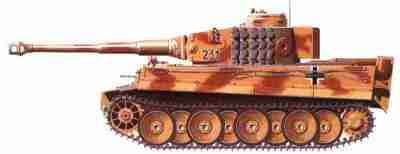Panzerkampfwagen VI Tiger, SdKfz 181


In 1937 the German Armaments Ministry issued a specification for a new heavy tank to
Daimler-Benz, Henschel, MAN, and Porsche. The project, however, was ignored when the new
PzKpfw III
and
IV served well in combat,
and was not revived until the spring of 1941.
Allied heavy tanks, like the French Char B1 bis and British Matilda I, had impressed Hitler
during the campaign in the West. In May 1941 he issued a specification for a heavy tank
weighing about 45 tons carrying a variant of the 88mm anti-aircraft gun. Prototypes of the
new tank, alongside those of the
Panther,
were to be ready for demonstration on his birthday, 20 April 1942.
Henschel and Porsche began work at once on the VK.4501, as the prototype was code-numbered
(VK=Volkettenfahrzeuge or fully-tracked experimental vehicle; "45" means the tank belonged
to the 45-ton class, and "01" represents the first model to this requirement). The two
competing prototypes were ready and shown to Hitler at Rastenburg on the appropriate date.
The Henschel model was deemed slightly better and entered production in August as the
SdKfz 181 PzKpfw VI Tiger Ausf H (later changed to Ausf E in February 1944). At that time
the Tiger was sorely needed since the
PzKpfw III and
IV
were badly mauled by the T-34 and KV-1, whose superiority in 1941 had been overcome by
better training, tactics and communications on the German part.
Initially production of the Tiger stayed at a rate of 12 per month, but by November 1942 it
had been increased to 25. The Tigers were rushed into action in August 1942, with
disastrous results. They kept serving on all fronts till the end of the war. Production
reached its peak of 104 in April 1944 and finally ceased in August, after 1,355 had been
produced. By this time the Panther was in full production and the
King Tiger was just
entering action. The Tiger was an invaluable interim design, with thick armor almost
indestructible frontally against Allied tanks and guns, and the 88mm gun which could
destroy anything the Allies could put onto the field. It was, however, miserably
underpowered and thus mechanically unreliable, and the slow turret traverse speed made it
susceptible to surprise flank attacks. Despite these weaknesses, the Tiger was well feared
and respected by its enemies.
Early versions of the Tiger had an escape hatch in the turret side which was later
dispensed with. There were smoke dischargers also but were later eliminated. Tigers in
Africa and southern Russia were equipped with special air filters against sand and dust.
The Ausf Es had a more powerful engine than that of the Ausf H.
Hitler had dictated that the Tiger be armed with the 88mm gun, which made it a formidable
tank killer. The KwK 36 L/56 was for a long time the most powerful tank gun in service.
The Tiger provided the crew with a stable ride, mainly due to its interleaved and
overlocking roadwheels mounted on torsion bar suspension. However, the inner wheels were
very difficult to change if damaged.
The Tiger was usually assigned to independent heavy tank battalions which were then
allocated to divisions or corps for special missions, not as an integral part of the
divisions. There were, however, exceptions like the schwere Abteilungen which remained
part of individual divisions.
Back to German Tanks Page
Back to Heer Page
Back to Homepage